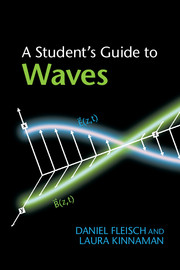1 - Wave fundamentals
Published online by Cambridge University Press: 05 April 2015
Summary
This chapter covers the fundamental concepts of waves. As with all the chapters in the book, you can read the sections within this chapter in any order, or you can skip them entirely if you're already comfortable with this material. But if you're working through one of the later chapters and you find that you're uncertain about some aspect of the discussion, you can turn back to the relevant section of this chapter.
In the first two sections of this chapter you'll be able to review the basic definitions and terminology of waves (Section 1.1) and the relationships between wave parameters (Section 1.2). Later sections cover topics that serve as the foundation on which you can build your understanding of waves, including vectors (Section 1.3), complex numbers (Section 1.4), the Euler relations (Section 1.5), wavefunctions (Section 1.6), and phasors (Section 1.7).
Definitions
When you're embarking on a study of new topic, it's always a good idea to make sure you understand the terminology used by people who discuss that topic. Since this book is all about waves, a reasonable place to start is by asking the question “What exactly is a wave?”
Here are some of the answers to that question that you may encounter in the literature.
“A classical traveling wave is a self-sustaining disturbance of a medium, which moves through space transporting energy and momentum.” [6].
“What is required for a physical situation to be referred to as a wave is that its mathematical representation give rise to a partial differential equation of a particular form, known as the wave equation.” [9].
“[The essential feature of wave motion is that a] condition of some kind is transmitted from one place to another by means of a medium, but the medium itself is not transported.” [4].
“[A wave is] each of those rhythmic alternations of disturbance and recovery of configuration.”
- Type
- Chapter
- Information
- A Student's Guide to Waves , pp. 1 - 43Publisher: Cambridge University PressPrint publication year: 2015

